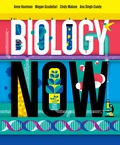
Concept explainers
During fertilization, two gametes fuse and produce a single cell termed as the zygote. The zygote contains a set of haploid (n) chromosomes from each gamete and thus resulting in the formation of a diploid (2n) set of genetic material. Diploid cells consist of two sets of chromosomes (2n), one derived from the maternal origin and the other derived from the paternal origin. Human cells carry two copies of chromosomes (22 pairs of autosomes) and a single pair of sex chromosomes.
Answer to Problem 1TQ
Homologous chromosomes contain a pair of similar kind of chromosomes; each chromosome inherited from each parent (one from maternal and one from paternal). Therefore, option b is correct.
Explanation of Solution
Justify the reasons for the correct statement:
Each homologous pair of chromosomes present in the zygote contains a set of chromosomes, one derived from the mother and another from the father. The human genome contains twenty three (23) pairs of chromosomes. Homologous chromosomes carry a similar kind of genetic information in their corresponding loci. All pairs (22 pairs) of chromosomes carry the same genes or genetic information except X and Y chromosomes. The X and Y chromosomes are known as sex chromosomes and they are involved in the determination of sexual characteristics in human beings. The remaining 22 pairs of homologous chromosomes are called autosomes.
The homologous pair of chromosomes found to be similar according to their size, physical character, pattern, and gene content. Homologous chromosomes carry two forms of a gene in the same locus are called alleles (same gene but different alleles).
Option (b) is given as, “a pair of chromosomes of the same kind”.
Hence, the option (b) is correct.
Justify the reasons for the incorrect statements:
Option (a) is given as, “the same thing as sister chromatids”.
Two identical DNA molecules after replication are known as sister chromatids. These chromatids are attached at the centromere until metaphase of the cell cycle. When sister chromatids are attached, it will be considered as a single chromosome. Hence, it is a wrong answer.
Option (c) is given as, “identical copies of the same chromosome”.
Two identical DNA copies of the same chromosome are known as sister chromatids. Hence, it is a wrong answer.
Option (d) is given as, “always haploid”.
A single set of chromosomes is known as a haploid. Hence, it is a wrong answer.
Hence, options (a), (c), and (d) are incorrect.
The homologous chromosomes are a pair of a same kind of chromosomes. They are inherited from the parents, one from the mother and another from the father.
Want to see more full solutions like this?
- ✓ Details Draw a protein that is embedded in a membrane (a transmembrane protein), label the lipid bilayer and the protein. Identify the areas of the lipid bilayer that are hydrophobic and hydrophilic. Draw a membrane with two transporters: a proton pump transporter that uses ATP to generate a proton gradient, and a second transporter that moves glucose by secondary active transport (cartoon-like is ok). It will be important to show protons moving in the correct direction, and that the transporter that is powered by secondary active transport is logically related to the proton pump.arrow_forwarddrawing chemical structure of ATP. please draw in and label whats asked. Thank you.arrow_forwardOutline the negative feedback loop that allows us to maintain a healthy water concentration in our blood. You may use diagram if you wisharrow_forward
- Give examples of fat soluble and non-fat soluble hormonesarrow_forwardJust click view full document and register so you can see the whole document. how do i access this. following from the previous question; https://www.bartleby.com/questions-and-answers/hi-hi-with-this-unit-assessment-psy4406-tp4-report-assessment-material-case-stydu-ms-alecia-moore.-o/5e09906a-5101-4297-a8f7-49449b0bb5a7. on Google this image comes up and i have signed/ payed for the service and unable to access the full document. are you able to copy and past to this response. please see the screenshot from google page. unfortunality its not allowing me attch the image can you please show me the mathmetic calculation/ workout for the reult sectionarrow_forwardIn tabular form, differentiate between reversible and irreversible cell injury.arrow_forward
- 1.)What cross will result in half homozygous dominant offspring and half heterozygous offspring? 2.) What cross will result in all heterozygous offspring?arrow_forward1.Steroids like testosterone and estrogen are nonpolar and large (~18 carbons). Steroids diffuse through membranes without transporters. Compare and contrast the remaining substances and circle the three substances that can diffuse through a membrane the fastest, without a transporter. Put a square around the other substance that can also diffuse through a membrane (1000x slower but also without a transporter). Molecule Steroid H+ CO₂ Glucose (C6H12O6) H₂O Na+ N₂ Size (Small/Big) Big Nonpolar/Polar/ Nonpolar lonizedarrow_forwardwhat are the answer from the bookarrow_forward
 Human Anatomy & Physiology (11th Edition)BiologyISBN:9780134580999Author:Elaine N. Marieb, Katja N. HoehnPublisher:PEARSON
Human Anatomy & Physiology (11th Edition)BiologyISBN:9780134580999Author:Elaine N. Marieb, Katja N. HoehnPublisher:PEARSON Biology 2eBiologyISBN:9781947172517Author:Matthew Douglas, Jung Choi, Mary Ann ClarkPublisher:OpenStax
Biology 2eBiologyISBN:9781947172517Author:Matthew Douglas, Jung Choi, Mary Ann ClarkPublisher:OpenStax Anatomy & PhysiologyBiologyISBN:9781259398629Author:McKinley, Michael P., O'loughlin, Valerie Dean, Bidle, Theresa StouterPublisher:Mcgraw Hill Education,
Anatomy & PhysiologyBiologyISBN:9781259398629Author:McKinley, Michael P., O'loughlin, Valerie Dean, Bidle, Theresa StouterPublisher:Mcgraw Hill Education, Molecular Biology of the Cell (Sixth Edition)BiologyISBN:9780815344322Author:Bruce Alberts, Alexander D. Johnson, Julian Lewis, David Morgan, Martin Raff, Keith Roberts, Peter WalterPublisher:W. W. Norton & Company
Molecular Biology of the Cell (Sixth Edition)BiologyISBN:9780815344322Author:Bruce Alberts, Alexander D. Johnson, Julian Lewis, David Morgan, Martin Raff, Keith Roberts, Peter WalterPublisher:W. W. Norton & Company Laboratory Manual For Human Anatomy & PhysiologyBiologyISBN:9781260159363Author:Martin, Terry R., Prentice-craver, CynthiaPublisher:McGraw-Hill Publishing Co.
Laboratory Manual For Human Anatomy & PhysiologyBiologyISBN:9781260159363Author:Martin, Terry R., Prentice-craver, CynthiaPublisher:McGraw-Hill Publishing Co. Inquiry Into Life (16th Edition)BiologyISBN:9781260231700Author:Sylvia S. Mader, Michael WindelspechtPublisher:McGraw Hill Education
Inquiry Into Life (16th Edition)BiologyISBN:9781260231700Author:Sylvia S. Mader, Michael WindelspechtPublisher:McGraw Hill Education





